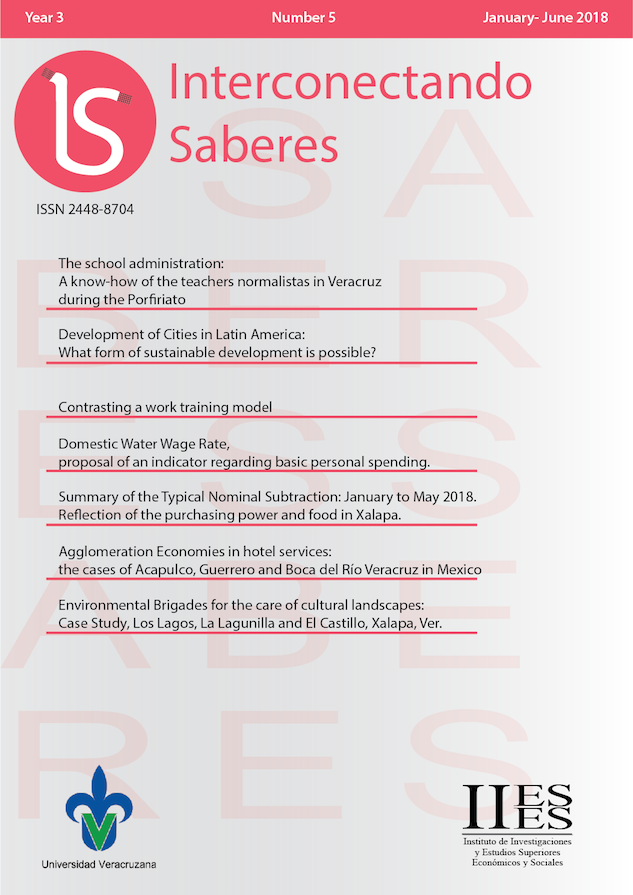Abstract
An interpretation and comparative analysis of the hotel agglomerations in Acapulco and Boca del Río is presented, covering a study of the economic - tourist development. The analysis is based on information obtained from the INEGI through the DENUE and the Digital Map. The study revealed that hotels are grouped around the coasts with the beach as the focus of attraction, this has given rise to other agglomerations that benefit the hotel industry but also contribute to it.
References
Alburquerque, F. (2006). CLUSTERS, TERRITORIO Y DESARROLLO EMPRESARIAL: DIFERENTES MODELOS DE ORGANIZACIÓN PRODUCTIVA. Cuarto Taller de la Red de Proyectos de Integración Productiva del Fondo Multilateral de Inversiones (MIF/FOMIN) , 3 - 4.
Barquero, A. V. (2006). Surgimiento y Transformación de Clusters y Milieus en los Procesos de Desarrollo. Eure, 77.
CONCANACO SERVYTUR. (2017). Boletín Turismo. México: Dirección de Turismo y Comercio Extererior.
Concanaco Servytur México. (2017). Indicadores de Guerrero. Obtenido de Concanaco.com.mx: http://www.concanaco.com.mx/documentos/indicadores-estados/Guerrero.pdf
DATATUR. (2017). Información Turística por Entidad Federativa. Obtenido de SECTUR: http://www.datatur.sectur.gob.mx/ITxEF/ITxEF_VER.aspx
Hernández, D. F. (2014). Las Economías de Aglomeración y el Empleo: Caso de Estudio el Veneto, Italia. Veracruz, México: MaJoMa Editorial y Editorial Lulú.
Instituto Nacional de Estadística y Geografía. (s.f.). INEGI. Obtenido de INEGI: http://www.inegi.org.mx/geo/contenidos/mapadigital/
Manrique, O. L. (2006). Fuentes de las Económias de Aglomeración: Una Revisión Bibliográfica. 55.
Quintar, A., & Gatto, F. (1992). Distritos Industriales Italianos Experiencias y Aportes Para el Desarrollo de Políticas Industriales Locales. CEPAL, 11.
Rodríguez Domínguez, M. (2001). LA CREACIÓN DE CLUSTERS TURÍSTICOS COMO INSTRUMENTO PARA LA MEJORA COMPETITIVA DE LOS DESTINOS: UNA APLICACIÓN A LAS RÍAS BAJAS GALLEGAS. Investigaciones Europeas de Dirección y Economía de la Empresa, 119.
Sagarpa, & FAO. (2013). AGLOMERACIONES PRODUCTIVAS (“CLUSTERS”): UNA VÍA PARA IMPULSAR LA COMPETITIVIDAD DEL SECTOR AGROALIMENTARIO EN MÉXICO. México .
Secretaría de Turismo. (22 de Junio de 2017). El Momento Turístico Que Vive México, El Mejor Que Se Ha Vivido En Su Historia. Obtenido de gob.mx: https://www.gob.mx/sectur/prensa/el-momento-turistico-que-vive-mexico-el-mejor-que-se-ha-vivido-en-su-historia?idiom=es
Secretaría de Turismo. (08 de Febrero de 2018). Generó 1,990 Millones De Pesos De Derrama Económica Primer Fin De Semana Largo Del Año. Obtenido de gob.mx: https://www.gob.mx/sectur/prensa/genero-1-990-millones-de-pesos-de-derrama-economica-primer-fin-de-semana-largo-del-ano?idiom=es
Secretaria de Turismo de México. (10 de Abril de 2016). gob.mx. Obtenido de gob.mx: https://www.gob.mx/sectur/prensa/turismo-factor-relevante-para-la-economia-mexicana-enrique-de-la-madrid
Secretaría de Turismo de México. (13 de Marzo de 2018). Panorama del Sector Turístico. Obtenido de Consejo de Promoción Turística de México: http://www.cptm.com.mx/panorama-del-sector-turistico?language=es
SECTUR. (28 de 04 de 2014). Acapulco. Obtenido de Gob.mx: http://www.sectur.gob.mx/programas/gestion-de-destinos/productos-turisticos/bloque-pacifico-y-mar-de-cortes/acapulco/
Sectur, BBVA Data & Analytics, BBVA Bancomer. (2015). Veracruz. Obtenido de Sectur: http://www.datatur.sectur.gob.mx/Documentos%20Publicaciones/BIGDATA_Veracruz.pdf#search=boca%20del%20r%C3%AD%C3%B3
Sistema de Información de Estadísticas Turísticas - DATATUR. (2018). Empleo Turístico. Obtenido de Sectur: http://www.datatur.sectur.gob.mx/SitePages/ResultadosITET.aspx
Strange, W. C. (2005) Urban Agglomeration. New Palgrave Dictionary of Economics, 2da Edición, Macmillan.
World Tourism Organization. (2015). UNWTO Tourism Highlights. Obtenido de e-unwto.org: https://www.e-unwto.org/doi/pdf/10.18111/9789284416899

